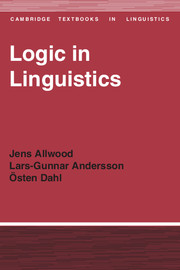Book contents
- Frontmatter
- Contents
- Preface
- Symbols and notational conventions
- 1 Logic for linguists
- 2 Set theory
- 3 Inference and logical analysis of sentences
- 4 Propositional logic
- 5 Predicate logic
- 6 Deduction
- 7 Modal logic
- 8 Intensional logic and categorial grammar
- 9 Further extensions
- 10 Logic for linguists?
- References
- Answers to exercises
- Index
2 - Set theory
Published online by Cambridge University Press: 05 June 2012
- Frontmatter
- Contents
- Preface
- Symbols and notational conventions
- 1 Logic for linguists
- 2 Set theory
- 3 Inference and logical analysis of sentences
- 4 Propositional logic
- 5 Predicate logic
- 6 Deduction
- 7 Modal logic
- 8 Intensional logic and categorial grammar
- 9 Further extensions
- 10 Logic for linguists?
- References
- Answers to exercises
- Index
Summary
Sets and elements
In the following chapters, we shall often use concepts taken from set theory. In addition to its connections with logic, set theory is fundamental to mathematics and has a number of direct applications in linguistics. We shall therefore start by characterizing briefly the most important concepts in this field.
A set is a number or collection of things or entities of any kind. Other terms that are often used to refer to sets are ‘class’ and ‘group’ (although these also have other, technical uses in mathematics). A set consists of a number of elements or members. The sets we have occasion to talk about in everyday life usually consist of elements that have something in common, such as the set of all Swedes or the set of all books in a certain library. Set theory puts no such restriction on sets: a set can be formed out of elements that have no connection whatsoever. We might for instance choose to consider the set which consists of the Premier of Sweden, the smallest moon of Mars and the square root of 7.
Some notational conventions: we shall use italic capital letters (A, B, C …) to refer to sets and italic lower-case letters (a, b, c …) to refer to the individual objects that are members of the sets.
- Type
- Chapter
- Information
- Logic in Linguistics , pp. 3 - 14Publisher: Cambridge University PressPrint publication year: 1977



